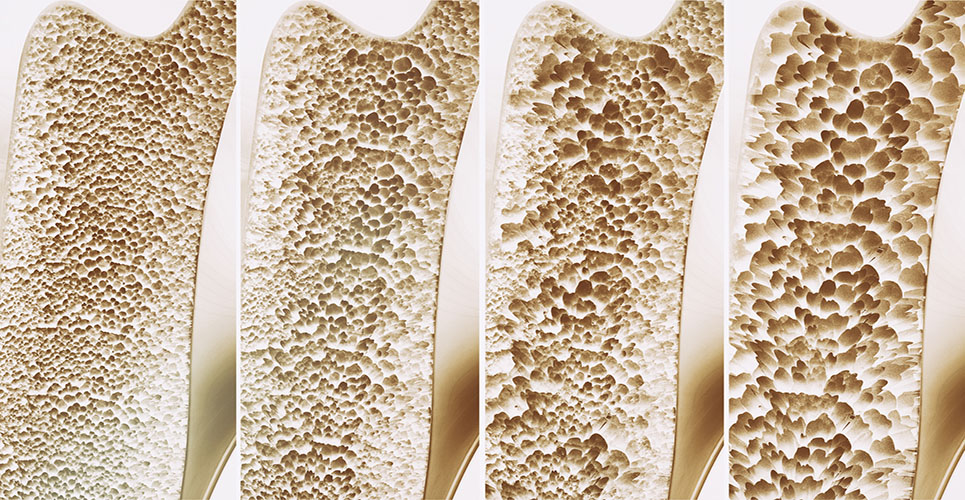UCB has announced findings from the FRAME study showing that the investigational agent romosozumab significantly reduced the incidence of new vertebral fractures in postmenopausal women with osteoporosis through 12 and 24 months, meeting the study’s co-primary endpoints.
UCB has announced findings from the FRAME study showing that the investigational agent romosozumab significantly reduced the incidence of new vertebral fractures in postmenopausal women with osteoporosis through 12 and 24 months, meeting the study’s co-primary endpoints.
The results from the Phase III study, the first to evaluate fracture risk reduction as early as one year as a primary endpoint, were published in the New England Journal of Medicin, and presented in an oral session at the American Society for Bone Mineral Research (ASBMR) annual meeting in Atlanta, Georgia. Romosozumab works by binding and inhibiting the activity of the protein sclerostin, and as a result has a dual effect on bone, both increasing bone formation and decreasing bone breakdown.
“Treatment data show that only one in five women who have experienced an osteoporotic fracture are started on treatment for the disease,1despite the fact that patients who experience an osteoporotic fracture are twice as likely to suffer a future fracture,2”said study lead author Felicia Cosman, MD, Medical Director of the Clinical Research Center at Helen Hayes Hospital and Professor of Medicine at Columbia University College of Physician and Surgeons in New York. “The FRAME results demonstrate that romosozumab, with its dual effect of increasing bone formation and decreasing bone resorption, has the potential to reduce the risk of new vertebral and clinical fractures within 12 months, in addition to showing improvements in bone mass, with sustained benefits upon transition to denosumab thereby addressing a critical treatment need for patients at increased risk of fracture.”
FRAME (FRActure study in postmenopausal woMen with ostEoporosis), which enrolled 7180 women, showed that those randomly assigned to receive a monthly subcutaneous 210mg dose of romosozumab experienced a statistically significant 73% reduction in the relative risk of a new vertebral (spine) fracture through 12 months, compared to those receiving placebo (fracture incidence 0.5% vs. 1.8%, respectively [p<0.001]). Of interest, the data showed that by six months, new vertebral fractures occurred in 14 romosozumab and 26 placebo patients, and between six to 12 months, fractures occurred in two additional romosozumab versus 33 additional placebo patients.
There was a statistically significant 75% reduction in the risk of vertebral fracture at month 24 (the other co-primary endpoint) in patients who received romosozumab followed by denosumab vs. placebo followed by denosumab (fracture incidence 0.6% vs. 2.5%, respectively [p<0.001]). In the second year of the study, new vertebral fractures occurred in five patients who transitioned from romosozumab to denosumab and 25 patients who transitioned from placebo to denosumab.
In clinical fractures, patients receiving romosozumab experienced a statistically significant 36% reduction in the relative risk of a clinical fracture, a secondary endpoint, through 12 months compared to those receiving placebo (fracture incidence 1.6% vs. 2.5%, respectively [p=0.008]). A 33% reduction in relative risk of clinical fracture was observed through 24 months after patients transitioned from romosozumab to denosumab compared to patients transitioning from placebo to denosumab (nominal p=0.002, adjusted p=0.096). Romosozumab resulted in a 25% reduction compared to placebo in the relative risk of non-vertebral fractures through month 12, another secondary endpoint. For the non-vertebral fracture endpoint, the overall fracture incidence in the study was lower than expected (2.1% in the placebo group in year one versus an expected rate of 3.5%).
In a substudy of 126 subjects, romosozumab increased bone mineral density with gains of 9.7% and 4.7% from baseline by six months at the lumbar spine and total hip, respectively, and gains of 13.3% and 6.8% at 12 months (all comparisons versus placebo p<0.001). Bone mineral density continued to increase in the romosozumab group after transitioning to denosumab, reaching a 17.6% and 8.8% increase from baseline at the lumbar spine and total hip, respectively, at 24 months (p<0.001 compared to placebo-to-denosumab group for all comparisons).
“To reduce the growing global burden of this prevalent chronic disease more decisive steps need to be takennow for identifying, diagnosing and appropriately treating people with osteoporosis at an increased risk of fracture”, said Dr Pascale Richetta, Head of Bone and Executive Vice President, UCB.
“We are pleased to see nearly 15 years of sclerostin antibody research reinforced with these Phase 3 data. Romosozumab with its dual effect as a bone builder and anti-resorptive has the potential to play a distinct and important role in the treatment of women with postmenopausal osteoporosis at increased risk of fracture,” said Sean E Harper, MD, Executive Vice President of Research and Development at Amgen. “These positiveFRAME study results are the basis of our Biologics Licensing Agreement that we submitted to the FDA in July, and we look forward to working with regulatory authorities to help make this potential treatment option available to patients.”
References
- Wilk A et al. Post-fracture pharmacotherapy for women with osteoporotic fracture: analysis of a managed care population in the USA. Osteoporosis Int. 2014;25(12):2777−2786.
- International Osteoporosis Foundation. Stop at One. One Fracture Leads to Another. http://share.iofbonehealth.org/WOD/2012/patient_brochure/WOD12-patient_brochure.pdf. Accessed August 29, 2016.

